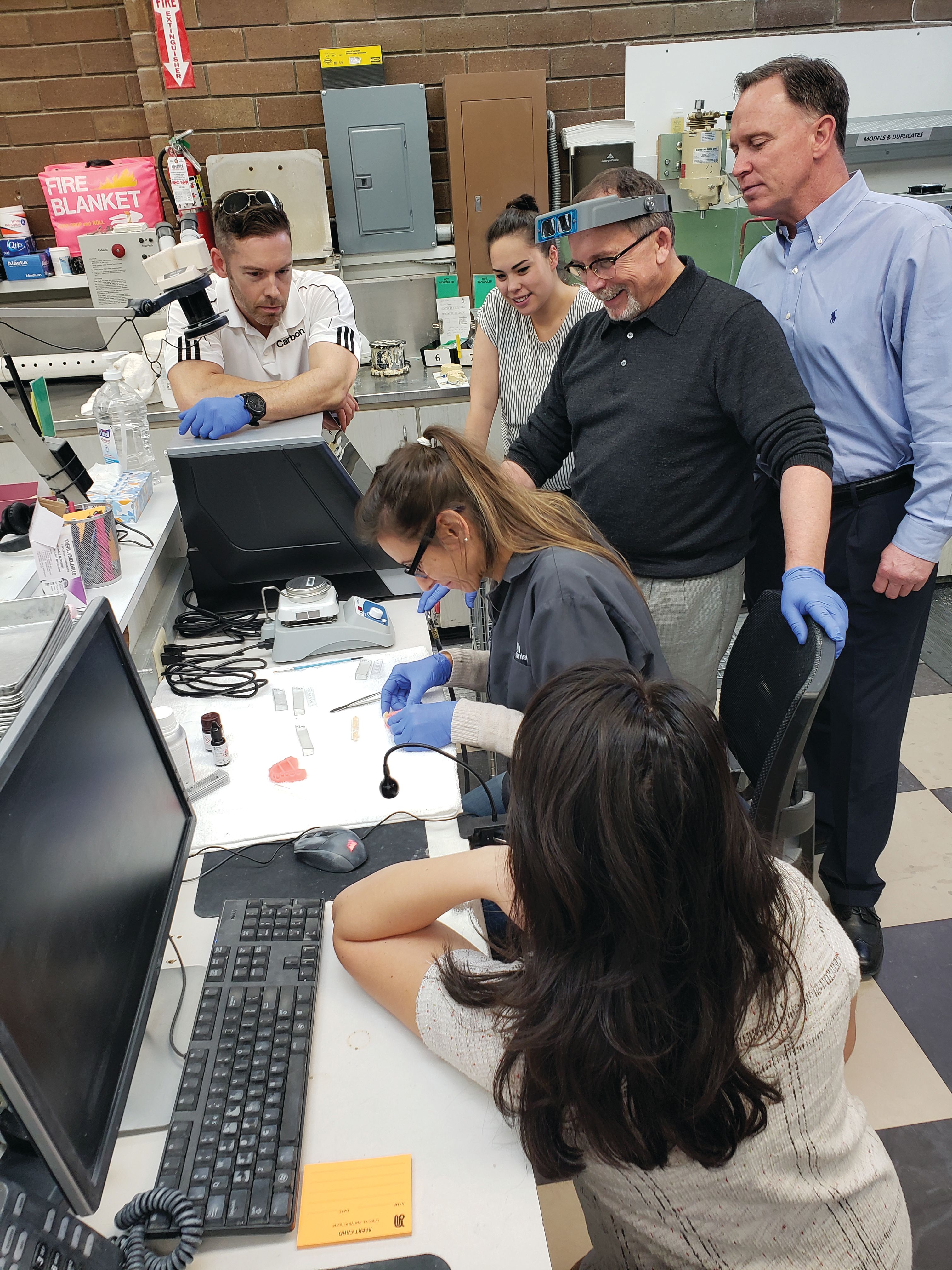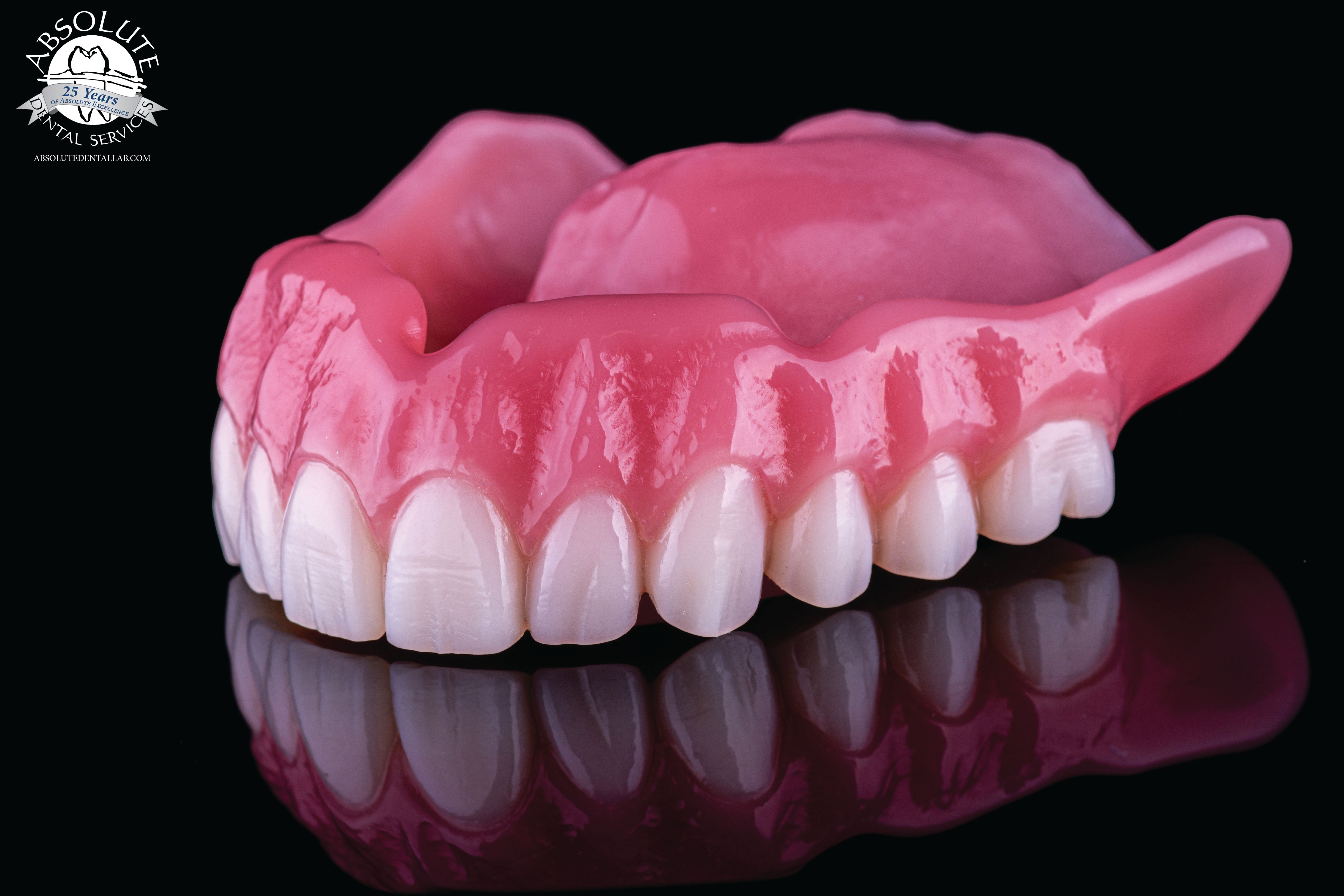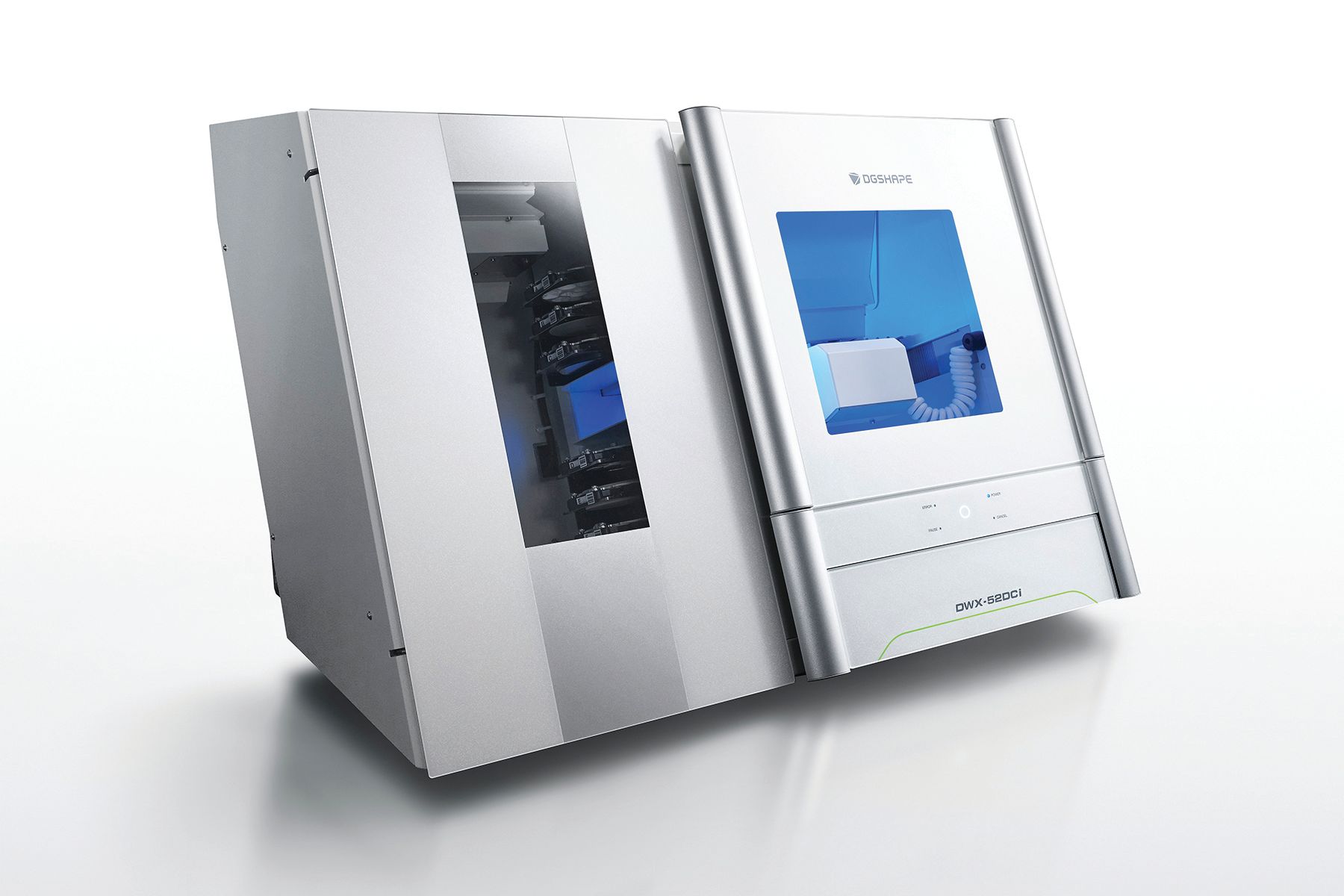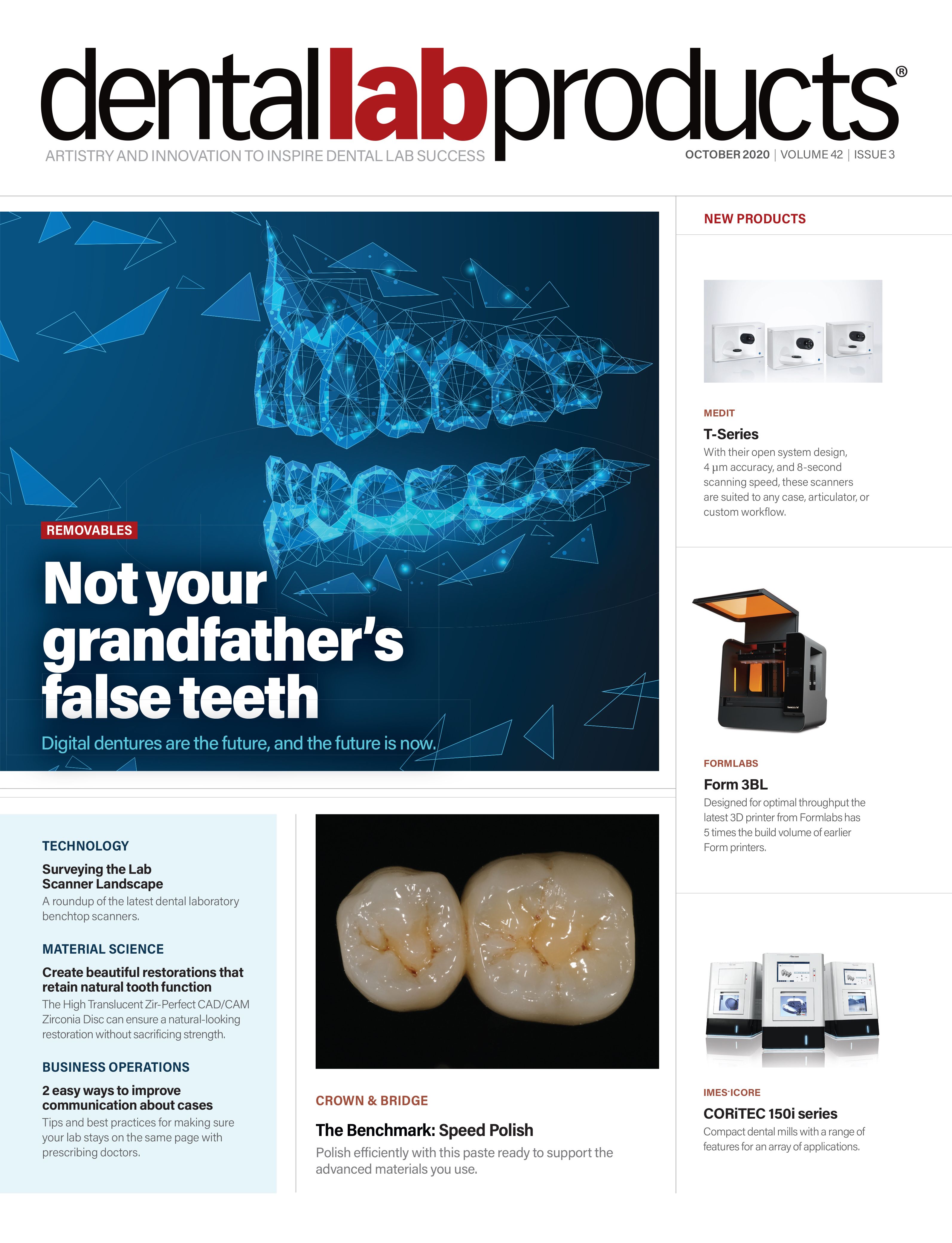Not Your Grandfather’s False Teeth
Digital dentures are the future, and the future is now.
YABARSART / STOCK.ADOBE.COM

According to 1989’s Back to the Future Part II, by 2015, we would have video billboards, flying cars, and hover boards. We certainly got those billboards (yay), but the film missed the boat on the airborne items. For all the technologies that it mistakenly prophesied we’d have by now, there are just as many advances it didn’t anticipate, such as smartphones, global positioning systems, and digital dentistry. In fact, if the movie had predicted that dentists would be creating crowns right in the office, it might have lost some believability at that time.
Even crazier: Dentures can now be designed on a computer and materialize seemingly out of nowhere, thanks to 3D printing. CAD/CAM has made the creation of dental prosthetics less expensive, more predictable, and endlessly reproducible. In 2020, digital dentures are on the cutting edge of dental prosthetics.
Evolving Methods
Historically, dentures were made by hand. But in 2012, labs were able to use a computer to design and create dentures. The 2 methods for denture fabrication are milling and 3D-printing.
Milling is a subtractive process; that is, a block of material is loaded into a milling machine and little by little, the machine carves away bits of the block. On the other hand is 3D printing, an additive process: The 3D printer creates the denture components out of resin, just a fraction of a millimeter at a time.
In each method, the teeth and the baseplate are created separately, and after some processing, the teeth are cemented into the baseplate. Both methods have pros and their cons.
“Over the years, the demand for dentures has increased, due to an aging population,” Lisa Aguirre, product manager of dental solutions for DGSHAPE Americas, a Roland DGA company, says. “The traditional denture-making process continues to provide high-quality, predictable results; however, the process is time-consuming, messy, and labor-intensive for laboratory technicians. This lengthy process includes multiple visits for the patient and 4- to 6-week turnaround times from start to finish.”
Digital fabrication techniques remove those hurdles. “It’s gone fully digital, which means that you can now not only take a scan in from an intraoral scanner or an impression stone [but also] develop it using the different softwares,” Todd Rutkus, CDT, support and training specialist at Benco Dental, says. “You can develop this new denture fully on the screen and then print it. And there are different ways you can print it out. One way is printing the base and then taking the teeth off a card, using a resin to cement the teeth into that printed baseplate. They can literally print the baseplate and print the teeth and put them together.”
Nakanishi Dental Lab in Bellevue, Washington, is a great example of how one lab’s journey toward digital dentures has paralleled the larger industry. Nakanishi has followed dental lab industry methods and trends for almost 70 years, starting with current co-owner Megan Nakanishi’s grandfather and then moving to her father.
“Digital dentures have been this elusive thing for several years now,” Nakanishi says. “Early on, we invested in a digital denture system, but it wasn’t truly a digital denture at that point. There were some digital aspects to it, but the result was still a traditional denture. Although our company was—and still is—committed to digital workflows, we very quickly reverted back to our old ways, because we said, ‘This digital denture is too expensive and takes too long to produce for something that is no better than our traditional denture.’
“We decided at that point to hold off on pursuing digital dentures until there was truly a digital solution,” Nakanishi continues. “We sat on the sidelines for many years until finally Dentsply and Carbon came out with the Lucitone Digital Print [LDP] 3D-printed denture. When our team first saw that denture, we all looked at each other like ‘OK, this is the real deal.’ The LDP denture is a true digital denture that provides our clients and their patients with benefits that traditional dentures just cannot provide. It’s ‘better, faster, cheaper,’ and our team is excited.”
DGSHAPE milling Time Reduction Kits (TRK) from Roland DGA (Photo courtesy of Roland DGA).

Labs that embrace CAD/CAM see a clear benefit to the method and seem eager to promote the technology, where appropriate. “Our goal is to do everything as digital as possible,” Conrad Rensburg, owner and head of dental implants at Absolute Dental Services, says. “We’re obviously heavily invested in Carbon with the Lucitone 3D print material. We also do very limited milling of dentures, and then we also have hand processing. We’re doing about 80% digital. We’re trying to transition our customer base to as much digital as possible. As soon as we have a case delivered, we have a digital archive of that file. And if that patient comes back 4 years from now, we can print out the original try-in, they refresh the intaglio, and we go straight to finish. So, it’s a much smoother workflow if you do it digitally than it is by hand.”
Multiple Advantages
The gee-whiz aspect aside, the creation of digital dentures offers obvious advantages for the lab technician, clinician, and patient.
“Conventionally processed dentures undergo polymerization shrinkage, so CAD/CAM-milled, complete dentures are a much, much better fit, intraorally, than the conventional ones,” Nadim Z. Baba, DMD, MSD, FACP, a professor in the Advanced Dental Education Program in Implant Dentistry at Loma Linda University School of Dentistry, says. “The second advantage is that the prepolymerized acrylic resin has improved physical properties. Because the material is much stronger,…it can be milled in a thinner layer, so it makes it more comfortable for the patient. When produced, the CAD/CAM PMMA [poly(methyl methacrylate)] blocks are prepolymerized and fabricated under vacuum with 5 to 6 bars of pressure. For this reason, they have a higher degree of monomer conversion [less residual monomer], they have less porosity [and] are more dense, and the polymerization shrinkage has already taken place.”
Digital dentures also involve fewer visits to the dentist, a plus for both dentist and patient. “The number of visits that the patient has to [make] to the dentist is usually less now,” Dr Baba says. “Instead of the conventional 5 appointments for dentures, that could be shrunk. CAD/CAM dentures can offer up to 2 visits before the dentures can be delivered. Digital dentures can make it more cost-effective by decreasing the clinician’s overhead.”
Because the denture files are maintained on the lab’s computer, lost dentures are easily reproduced. “The lab technician keeps the denture data in his computer while he designs your dentures,” Dr Baba says. “So, God forbid the patient loses the denture—goes to the hospital and the hospital throws the denture in the garbage—what happens is that you can call the company, get these files, and make new dentures for the patient.”
Technicians realize their own benefits; namely, speed. “They do require a shorter time for the production when compared [with] conventional complete dentures,” Dr Baba says. “The second advantage is that the data require fewer lab steps. They don’t have to use any gypsum. They don’t have to use an articulator. They don’t have to use wax. It’s all digital. The digital software allows for a quicker analysis and faster denture teeth setup because they can flip the model and turn 60°, move the teeth with a lot of ease. It just needs a little bit of a learning curve to learn about the software. The lab technician can provide the clinician with a more accurate, high-quality, complete denture. Also, the dental technician is not exposed to monomer for the fabrication of removable prosthesis, so it makes it much healthier for [them].”
Maybe even more important is access to a fantastic tool that both crafts adventure and teaches the technician.
“It is definitely helping more, if you are driving the technician to give a superior product,” Chris Love, removables department manager at Absolute Dental Services, says. “If you want to just have somebody sit there and press a button and let the teeth be where they are, the CAD/CAM can definitely do that, but we actually look at a denture setup, and we’re able to follow what that doctor gave us. It’s a really good tool, as long as you’re using it as a tool rather than as something to speed up the process. It will speed up the process, but you’re also able to teach people a little bit easier about occlusal schemes, the way you’re able to manipulate the arches. I think it’s going to be a huge way to teach people more efficiency.”
Areas of Resistance
Digital dentures face challenges to acceptance, such as convincing client doctors of the new process’ benefits. Traditional analogue methods remain prevalent and, for some doctors, very comfortable.
“It’s still very much entrenched,” Rutkus observes. “Digital [has grown] at an incredible pace the last 2 years; it’s probably grown by at least 50%. However, when you look at the overall picture of denture sales, it’s still a drop in the bucket of what is traditionally sold, as far as materials. So it’s gaining, and it’s gaining because the doctor wants to do stuff in his office, which, 10 years ago, wasn’t even thought of.”
Nakanishi Dental Lab team training on Lucitone Digital Print denture fabrication. (Photo courtesy of Nakanishi Dental Lab).

“It’s a new way of producing dentures and educating your clients who have been doing dentures for decades in the same exact way,” Nakanishi adds. “Even though it’s a better product and it’s a better process and it saves them time and money, that change is always something to deal with.”
Another issue: Some dentists might want to just practice dentistry and not take on new roles. But Rutkus downplays that factor: “There used to be a saying, ‘No doctor wants to become a technician and waste his time doing this stuff. He’s always going to send it out to a lab,’” he says. “That’s not the case. The doctor’s saying, ‘Why should I pay a lab bill when I can do this stuff in-house?’”
The systems present their own challenges, which may or may not be insurmountable, depending on the lab. For instance, the expense may be an issue, especially for smaller labs. Depending on the system, the cost of equipment can be prohibitive, with some vendors charging yearly subscription fees.
“You must be prepared to invest in the equipment and materials,” Nakanishi says. “It can seem expensive at first, but the amount of time you are saving in labor can more than pay for the technology with the right amount of volume.”
From a practical standpoint, digital dentures do differ from conventionally made dentures, both in form and function.
“CAD/CAM dentures present several disadvantages when you compare them [with] conventionally processed, complete dentures,” Dr Baba says. “The first disadvantage is when you take manufactured denture teeth and you bond them manually to the milled denture bases, which means that even if you designed the dentures virtually and you bonded the teeth manually, they’re not going to go in the same position where you designed them on the computer. For that, what the lab technician needs to do is mount the dentures on an articulator to develop a balanced occlusion.”
Tooth-to-base fusing picture (Photo courtesy of Absolute Dental Services).

Despite its convenience, CAD/CAM is not a turnkey solution, especially for clinicians. “Multiple CAD/CAM complete dentures need to be made before the clinician feels that they have mastered the system,” Dr Baba says. “There’s a learning curve, and this might cause some disappointment and less-than-ideal results. People are financially oriented, and they don’t want to learn something new, because they’re scared that it’s going to take away from their chair time and they’re never going to make enough money. But, like anything new, there’s a learning curve.”
The virtual nature of the dentures can pose another challenge. For some labs and clinicians, the ability to share those files electronically is a huge benefit—the files can be instantly transmitted. On the other hand, those who prefer to handle the physical device are at a disadvantage.
“Communication with the dental lab can become more challenging,” Dr Baba says. “It may require multiple efforts to resolve design-related issues. If you send me a conventional denture and you’re a lab technician, I’m going to look at it, and if I don’t like something, I heat the wax and move the teeth or write down: ‘Well, it looks like the central incisors are too long. Would you shorten them?’ Here, you’re going to send me a design over the computer. I can’t touch it. I can’t hold it in my hand. I just have to grab my mouse and move it. A lot of people are not comfortable with that, and they have difficulty communicating with the lab technician.”
Constant Evolution (even still)
CAD/CAM continues to evolve; for example, early 3D-printed dentures still required an analogue component.
“Ten years ago, we weren’t printing complete dentures,” Jeremy Wohlers, CDT, technical field consultant at Kulzer, says. “When it first came in, we were printing, basically, a wax version of the denture, and you still had to use traditional methods to make the denture because we didn’t have FDA [Food and Drug Administration]–approved products. The technology of being able to produce something with additive technology, meaning a printer—that’s now the current state that we’re in. The race is the products that we can print; not necessarily the restoration itself but actual printer material that we’re printing. It has to be FDA approved and designed to be used in the mouth for what we’re wanting it to do. We do work pretty hard to make sure that we’re part of the tip of the sword with technology when it comes to printing.”
Wohlers saw the advance of CAD/CAM technologies as they benefited, first, fixed restorations. As a removable restoration technician, he hoped that one day those same methods and processes could be applied to his field. “I wanted it to be the Jetsons-era of dentures,” he says. “It’s fun to watch. We are in the entry stages of it. There’s still so much more to come, but it’s changing every day.”
Even advanced milling had room for improvement. As 3D printing became a more viable option, labs realized both speed and capacity increases.
“If you look at a PM7, which is kind of the gold standard of milling dentures, you can probably mill about 2½ dentures a day because it’s not a continuous printing,” Rensburg says. “Ivoclar [Vivadent] just launched their Ivotion puck, which is a single puck with the teeth and base, all in one, but you’re still looking at about a 2½-hour process to mill a denture in that new puck.”
3D-printed, Lucitone Denture (Photo courtesy of Absolute Dental Services).

“You have to remember, the mill cannot mill the undercuts that the printer can print,” adds Love. “So, there [are] a few advantages of printing. To give you an idea, with 1 Carbon printer, we can run about 12 bases in a 2½-hour cycle. So we can run that, in a normal 8-hour day, 4 times. We can literally do, with 1 printer, 40 or 50 bases, compared to maybe 2 or 3 with milling.”
The size of the lab and how much work it does is an important determinant for the type of equipment used. “The milling unit, I would say, is more for a small lab or a small office that only wants to do 1 or 2 units of printing,” Rensburg observes. “The Carbon printer is more for higher-quality production-type labs. So, if you want to do more than, let’s say, 2 or 3 dentures a day, you can’t really invest in milling technology.”
One of the hurdles toward advancing the technology involves obtaining the FDA approvals needed for new materials and processes. “Every company has their own FDA approval process for their dentures, and, keep in mind, one thing is to have FDA-approved material, but the way that you use it—meaning that the printer, the way you cure it, all the way down to polish—that all has to be FDA approved,” Wohlers says. “We’re still, as an industry, constantly sending things into the FDA for approval, and it’s not just the product but also the process, and that takes time.”
Although 3D printing seems to be on the cutting edge of digital denture creation, for some, milling remains preferable. “3D-printed dentures have become a popular option for laboratories and clinicians over the years, as it provides fast denture development with, in most cases, a minimal investment,” Aguirre says. “However, 3D-printed dentures have recently received criticism over their durability, as well as the long-term health effects of resin, intraorally.
Milled dentures are becoming the preferred method of denture fabrication because of the precise, efficient digital workflows available; quick denture replication; and predictability of materials. Workflows for milled dentures, like DGSHAPE’s Denture Time-Reduction Kits, allow technicians to mill dentures out of any traditional pourable acrylic material, saving time and money. Milling has proved to provide predictable, long-lasting dentures.
Peering Further Into the Future
A lot could be done with a DMC DeLorean retrofitted for time travel, including looking even further into the future of digital dentures. Unfortunately, the best we can do is ask professionals what they anticipate or would like to see.
“I expect to see the demand for digital dentures to continue to grow and evolve,” Aguirre says. “Digital workflows are becoming faster and more precise, without compromising the quality of the final prosthetic product.”
The technology behind CAD/CAM is certainly an arena experts have their eyes on, but materials also matter. “The ideal technology—that, hopefully, somebody will figure out tomorrow—is how to print ceramics or a ceramic/polymer-type material,” Rensburg says. “The milling technology has kind of run its course. We went through the phase where it wasn’t that good. And the problem with milling is that it’s slow. It’s arduous. It’s just as high maintenance on the machines. You lose burs, you lose your suction, units run dry, and you’ve got to replace those. It’s a very expensive technology, and it’s very limiting. Printing, on the other hand—you can print any undercuts without ever wondering about the accuracy. I’m thinking that the next big evolution in our industry is that we’ll start printing zirconia or start printing some type of ceramic material with a polymer bond that’s approved for long-term intraoral use.”
Whatever the future face of the technology, Dr Baba believes dentists who don’t embrace the technology will fall behind. “CAD/CAM dentures are the future,” he says. “I believe that every single clinician needs to learn how to do them. They deliver a better service for the patient… They give them less issues, like less sore spots, less visits. And there [are] a lot of studies that have shown that post-delivery visits are reduced with CAD/CAM dentures. The patient sits less in your chair. It’s more cost-effective. You make more money.”
Dental mill from Roland DGA (Photo courtesy of Roland DGA).

He also looks to the ability of milling dentures from a single piece of monolithic material. “The teeth and the base are in 1 piece,” the dentist/educator says. “The teeth are not bonded anymore to the base. This makes the denture stronger, makes them more esthetic, and makes them nicer looking for the patient. So this is coming, and it’s coming fast. Ivoclar has launched the Ivotion system, and I think it’s going to be a very promising, phenomenal way of doing dentures.”
Intraoral scanning makes the CAD/CAM process easier, faster, and more accurate than physical impressions. Dr Baba wants to see that method advance even further. “I would like to be able to have a patient sit down in a CBCT-style machine and then scan his arches and his soft tissue,” he says. “Then, from there, they can design his dentures. I don’t know if it’s going to happen, but this is something that I would really love to see.”
There is a concern for labs as the ease of prosthetics creation advances. Specifically, if it becomes too easy, will labs, ultimately, be removed from the process?
“I love how simplified and streamlined the digital denture process is,” Nakanishi says. “But there is that thought [that] if it’s too easy, is the lab really necessary in the process? But where labs can add value now is on the technical side, by being a great resource for dentists. Many of our clients refer dentures out, but if we can help them through the process and be the catalyst for them to add a new profit center to their practice, how valuable are we now?
“We know the demand is there,” she continues. “Ten thousand baby boomers retire every single day. The demand for dentures is here. So now it’s just being able to capture that demand and help our clients feel comfortable along the way.”
Ultimately, the future is hazy, but whoever gets there first will likely define the shape of things to come.
“The answer is: Nobody knows,” Rutkus observes. “But as far as where it’s going to go, the only downfall of printing right now is time. Printing is like making a cake. Most people do 2 layers, and those layers are thick. They don’t have a lot of detail to do a 4-layer cake. It’s got much more detail, much more filling. So the problem with printing is [that] the more detail you have, the slower it goes, because it has to do more layers. I see that continue to get better. It has to…nobody can wait 2 hours for a denture.”
He likens it to chairside milling crowns. “That whole chairside industry exploded,” he continues. “And I see the same thing happening with the printing industry. They just need to get over this hump of the timing. They need a quantum leap in technology to get them through this slow, layer-by-layer printing. I think it’s coming. There are a ton of companies working on it very hard, because everybody knows that whoever gets there first wins with that technology. I’m sure that patients will be there, as well.”
Back to the Future Part II is a great movie, and for all the technologies and advances it got wrong, there are plenty it got right, but still some that it didn’t predict. Happily, even though digital dentures weren’t on its radar, this technological advance has certainly been welcomed by dentistry.
